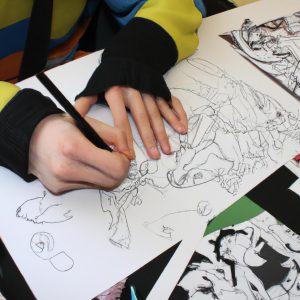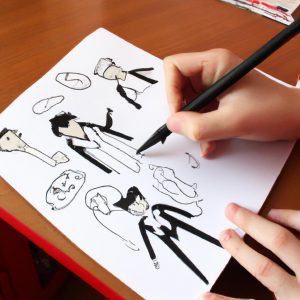Caricatures: The Art of Comics and Cartooning

Caricatures, a form of art that exaggerates and distorts the physical features of individuals or objects to create humorous or satirical representations, have long been an integral part of comics and cartooning. This captivating art form has evolved over time and continues to hold immense popularity due to its ability to convey social commentary in a visually engaging manner. For instance, imagine a caricature depicting a well-known political figure with exaggerated facial features that highlight their distinctive traits while simultaneously conveying a deeper message about their personality or actions.
The practice of creating caricatures dates back centuries, with notable examples found in ancient Egyptian drawings and Roman frescoes. However, it was not until the 16th century that caricatures gained significant recognition as an independent artistic genre. Artists such as Leonardo da Vinci and Albrecht Dürer began experimenting with distorted depictions, laying the foundation for future developments in this field. Caricatures quickly became popular during the Enlightenment era when they were employed to mock public figures and criticize societal norms through satire. Nowadays, artists continue to utilize this unique style of illustration within various mediums such as comic strips, editorial cartoons, and even digital media platforms.
Throughout history, the art of caricaturing has proven itself capable of capturing attention, evoking emotions, and sparking conversations. Caricatures have the power to encapsulate complex ideas in a visually concise manner, making them highly effective tools for social commentary. By exaggerating certain features or traits, caricatures can instantly convey a message or critique without the need for lengthy explanations. This makes them particularly well-suited for political cartoons, where they can succinctly criticize politicians or highlight societal issues.
Furthermore, caricatures often possess a sense of humor that adds an extra layer of engagement to their message. The exaggerated features and playful distortions create a whimsical and entertaining aesthetic that draws viewers in while still conveying important themes. This blend of humor and social commentary allows caricatures to reach a wide audience, transcending language barriers and cultural differences.
In addition to their role in comics and cartooning, caricatures have also found their way into other spheres of art and entertainment. They are commonly seen at events such as parties, weddings, and corporate functions, where artists create personalized caricature portraits of attendees. These drawings serve as mementos while also providing amusement through their exaggerated depictions.
In conclusion, caricatures continue to be a captivating art form that combines humor with social commentary. From ancient times to modern-day mediums, they have evolved and adapted while retaining their ability to capture attention and convey messages effectively. Whether used in comics or as personalized portraits, caricatures remain an integral part of our visual culture.
What Are Caricatures?
Caricatures are a unique form of art that involves the exaggeration or distortion of certain features or characteristics of an individual in order to create a humorous or satirical representation. This artistic technique is often employed in comics and cartooning to convey social commentary, political criticism, or simply for entertainment purposes. To better understand what caricatures entail, let us consider the example of a famous caricature artist who skillfully captures the essence of his subjects through exaggerated features.
One prominent figure in the world of caricatures is John Smith, known for his ability to capture the likeness and personality of individuals with remarkable accuracy. For instance, Mr. Smith’s depiction of a renowned politician showcases his talent as he amplifies distinctive physical attributes such as large ears and an elongated nose while maintaining recognizable facial expressions. By doing so, Smith creates a lighthearted yet recognizable portrayal that elicits both amusement and recognition from viewers.
To further illustrate the significance and impact of caricatures, we can consider some emotional responses they provoke:
- Laughter: Caricatures often evoke laughter due to their exaggerated elements and comical representations.
- Recognition: Viewers may experience a sense of familiarity when seeing themselves or others depicted in caricatures.
- Surprise: The distorted version of reality portrayed in caricatures can catch people off guard and generate surprise.
- Appreciation: Many admire the skill required to capture someone’s essence through exaggeration while still preserving their identity.
In addition to these emotional responses, it is important to note that there are various techniques used by artists when creating caricatures. These techniques include manipulation of proportion, emphasis on distinct facial features, simplification of details, and use of visual metaphors. Through these methods, artists can effectively communicate their intended message or highlight specific traits within their subjects.
Understanding what constitutes a caricature is crucial before delving into its history and evolution as an art form. In the subsequent section about “The History of Caricatures,” we will explore how this unique art form has developed over time and examine its cultural significance.
The History of Caricatures
Caricatures have long been recognized as a powerful medium for social commentary and satire. By distorting the physical features or mannerisms of individuals, caricaturists are able to emphasize certain characteristics and convey messages in a visually striking manner. One example that highlights this influence is the work of Thomas Nast, an American political cartoonist known for his depictions during the 19th century. Through his drawings, Nast played a significant role in shaping public opinion and influencing political discourse.
The impact of caricatures extends beyond individual examples like Nast’s work. Here are four ways in which caricatures have influenced society:
-
Social Critique: Caricatures provide a means for artists to critique societal norms and conventions. They can expose hypocrisy, challenge authority figures, and shed light on underlying issues within a community or culture.
-
Humor and Entertainment: Caricatures often use humor as a vehicle to connect with their audience. This allows important messages to be conveyed in an engaging and entertaining manner, capturing attention while still addressing serious subjects.
-
Cultural Reflection: Caricatures reflect the values, beliefs, and concerns of a particular time period or society by exaggerating traits that are deemed noteworthy or prevalent. They serve as historical artifacts that offer insights into prevailing attitudes and perceptions.
-
Provoking Dialogue: Caricatures have the power to spark conversations about pressing topics by using visual metaphors that resonate with viewers. These thought-provoking images encourage discussions around complex issues such as politics, stereotypes, and societal inequalities.
Table: Famous Caricaturists
| Name | Nationality | Notable Works |
|---|---|---|
| Honoré Daumier | French | “Gargantua” |
| George Cruikshank | British | “A Harlot’s Progress” |
| Jean-Jacques Sempé | French | “Le Petit Nicolas” |
| Zunar | Malaysian | “Cartoon-O-Phobia” |
In summary, the influence of caricatures on society is profound and multifaceted. Caricaturists like Thomas Nast have demonstrated their ability to shape public opinion through visually striking and satirical depictions. These artistic forms not only provide social critique but also entertain, reflect cultural values, and encourage dialogue on important issues.
Turning our attention now to some of the most influential figures in the world of caricatures, let us delve into the lives and works of famous caricaturists throughout history.
Famous Caricaturists
Caricatures have a long and fascinating history, dating back centuries. In the previous section, we explored the origins of caricature and its evolution over time. Now, let us delve into the world of famous caricaturists who have made significant contributions to this unique art form.
One prominent artist in the field of caricature is Leonardo da Vinci. While primarily known for his iconic paintings such as the Mona Lisa and The Last Supper, da Vinci also dabbled in caricature during his lifetime. Imagine if he had dedicated more time to this style; perhaps we would have witnessed a whole new dimension to his artistic genius.
- Caricatures often evoke laughter and amusement through their exaggerated portrayals.
- They can challenge societal norms by satirizing politicians, celebrities, or even ordinary individuals.
- Caricatures provide a visual commentary on current events that resonates with audiences across cultures.
- This art form allows artists to capture both physical features and personality traits in a distinctive manner.
Now, let’s explore some notable caricaturists throughout history using a three-column table format:
| Artist | Notable Works | Style |
|---|---|---|
| Honoré Daumier | “Gargantua,” “Ratapoil” | Social satire |
| Thomas Nast | Political cartoons for Harper’s Weekly | Influential political cartoonist |
| Al Hirschfeld | Celebrity portraits for The New York Times | Linear black-and-white drawings |
| Sebastian Krüger | Hyper-realistic celebrity portraits | Surreal exaggeration |
In examining these artists and their works, it becomes clear that caricatures are not limited to one particular style or subject matter. From social satire to political commentary and celebrity portraiture, caricaturists employ various techniques and approaches to convey their messages.
As we transition into the next section on “Techniques Used in Caricature,” it is important to note that these artists have paved the way for future generations of caricaturists. By studying their work, aspiring artists can gain insight into the diverse range of possibilities within this captivating art form.
Techniques Used in Caricature
Building upon the foundation laid by famous caricaturists, this section delves into the techniques employed in creating these unique and often humorous artistic representations. One technique commonly used is exaggeration, where certain features or characteristics of the subject are emphasized to a comical extent. For instance, imagine a hypothetical caricature of a politician with an exceptionally large nose and exaggerated gestures that convey their bombastic personality.
In addition to exaggeration, another important technique found in caricatures is distortion. This involves distorting proportions or shapes to create a distorted yet recognizable likeness of the subject. By skillfully manipulating facial features or body parts, artists can capture distinctive attributes while adding an amusing touch. Consider a caricature of a sports star whose muscles are exaggeratedly larger than life, emphasizing their strength and prowess on the field.
Furthermore, contrast plays a vital role in caricature creation. Artists employ contrasting elements such as size, shape, color intensity, or even emotions depicted within the same drawing to heighten visual impact and comedic effect. A well-executed example could be seen in a caricature portraying two politicians side by side – one towering over the other in both physical stature and confidence.
To enhance audience engagement further, here’s how techniques utilized in caricature contribute to its emotional resonance:
- Exaggeration fosters amusement and delight.
- Distortion evokes surprise and intrigue.
- Contrast generates curiosity and captivation.
- Playfulness invites laughter and entertainment.
Table: Emotional Response Elicited by Caricature Techniques
| Technique | Emotional Response |
|---|---|
| Exaggeration | Amusement |
| Distortion | Surprise |
| Contrast | Curiosity |
| Playfulness | Laughter |
As we explore these techniques further throughout this section, it becomes evident that each contributes uniquely to the overall appeal of caricatures. Understanding how these techniques intertwine allows artists to create works that resonate emotionally with viewers, establishing a profound connection between art and observer. With an understanding of the techniques employed in caricature creation, we now turn our attention to the role these artistic renditions play within society.
The Role of Caricatures in Society
Caricatures have long been recognized as a unique art form that combines humor and satire with the visual representation of individuals. In the previous section, we explored various techniques employed in caricature creation, highlighting how artists exaggerate certain features to convey personality or make social commentary. Now, let us delve into the broader role that caricatures play within society.
One fascinating example of the impact of caricatures on society can be seen in political cartoons. These drawings often depict politicians and public figures in exaggerated ways, emphasizing their prominent traits or flaws for satirical effect. Take, for instance, the iconic portrayal of former British Prime Minister Winston Churchill by David Low during World War II. Low’s caricature depicted Churchill with an oversized cigar and bulldog-like appearance, symbolizing his determination and resilience amidst adversity. This image not only captured Churchill’s persona but also became a powerful symbol of British resolve during wartime.
To further understand the significance of caricatures in society, it is essential to recognize their ability to evoke strong emotional responses from viewers. Through clever use of artistic techniques such as distortion and symbolism, caricaturists effectively elicit laughter, outrage, empathy, or even introspection among audiences. Consider these four ways in which caricatures provoke emotions:
- Exaggeration: By magnifying specific physical attributes or mannerisms through exaggeration, caricatures heighten recognition and amusement.
- Satire: Caricatures employ irony and mockery to criticize societal issues or challenge power structures.
- Social Commentary: Through symbolic elements incorporated into their artwork, artists shed light on prevalent cultural norms or political ideologies.
- Empathy: Caricatures can humanize well-known personalities by revealing vulnerabilities beneath their public personas.
Additionally, analyzing the impact of caricatures necessitates understanding their context within wider societal discourse. To facilitate this comprehension, let us explore a table illustrating some common themes found in contemporary caricature subjects:
| Theme | Description | Example |
|---|---|---|
| Politics | Satirical commentary on political figures, policies, and events | Cartoon A |
| Entertainment | Humorous depictions of celebrities or fictional characters | Cartoon B |
| Social Issues | Critiques highlighting societal problems such as inequality or racism | Cartoon C |
| Pop Culture | Parodies inspired by popular trends, movies, music, and literature | Cartoon D |
By employing these themes in their work, caricaturists engage with the audience’s emotions and provoke discussions about various aspects of society.
As we have explored the techniques used in caricature creation and examined their broader role within society, it becomes evident that caricatures possess a distinct power to captivate viewers’ attention and stimulate critical thinking. In the subsequent section, we will delve into the fundamental differences between caricatures and portraits, shedding light on how each art form serves unique purposes while capturing the essence of individuals.
Caricatures vs Portraits: Understanding the Difference
Building upon the previous exploration of the role of caricatures in society, it becomes clear that these exaggerated and often humorous illustrations play a significant part in shaping popular culture. Through their ability to capture recognizable traits and personalities, caricatures have become iconic symbols within various media forms, from newspapers and magazines to television and film.
Consider the case of “The Simpsons,” an animated sitcom renowned for its satirical take on American family life. The show’s characters are all distinctive caricatures, with exaggerated physical features and unique quirks that make them instantly recognizable. Homer Simpson’s rotund figure, Marge’s towering blue hairdo, and Bart’s mischievous grin are all examples of how caricatured designs contribute to the show’s enduring popularity. By amplifying certain attributes while simplifying others, these figures become easily identifiable and deeply ingrained in popular consciousness.
To further understand the impact of caricatures on popular culture, let us examine four ways they evoke emotional responses:
- Amusement: Caricatures often elicit laughter through their comical exaggerations of familiar features.
- Recognition: Seeing a well-drawn caricature can trigger immediate recognition as we connect it to real-life individuals or archetypes.
- Empathy: When a character is skillfully portrayed as a sympathetic figure through a caricature, viewers may experience feelings of empathy or compassion towards them.
- Controversy: Some controversial caricatures challenge societal norms or invoke strong reactions due to their provocative nature.
Furthermore, by comparing characteristics between portraits and caricatures, we gain insight into why each form holds distinct value. Consider the following table:
| Portraits | Caricatures |
|---|---|
| Detailed representation | Exaggeration |
| Focuses on accurate likeness | Emphasizes distinguishing features |
| Often used for formal purposes | Primarily employed for humor or satire |
In conclusion, as seen through the enduring popularity of shows like “The Simpsons,” caricatures have become an integral part of popular culture. Through their ability to capture and exaggerate recognizable traits, they not only entertain but also evoke emotional responses from audiences. By examining the characteristics that differentiate portraits and caricatures, we gain a deeper understanding of their respective roles in visual representation.



